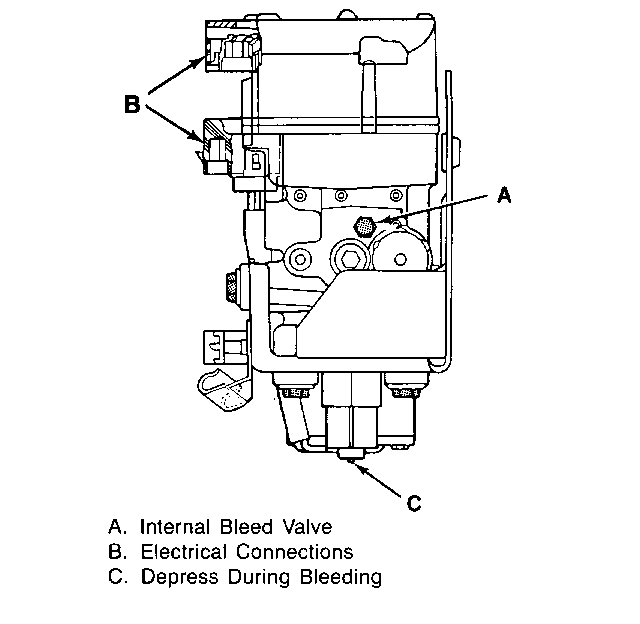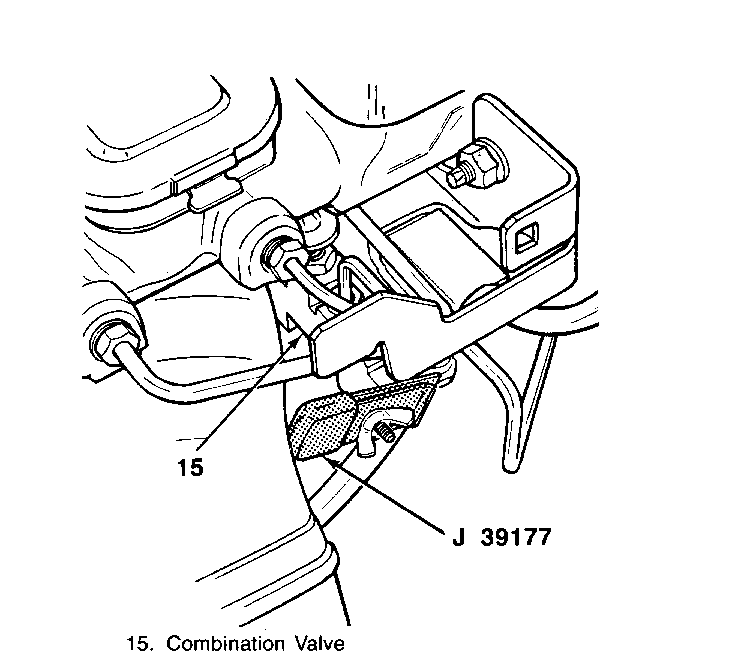SERVICE MANUAL UPDATE-SEC 5E1 REVISED BPMV BLEED PROCEDURE

SUBJECT: REVISED 4WAL BLEEDING PROCEDURE
MODELS: ALL 1990-1993 LIGHT DUTY TRUCKS WITH 4WAL
BLEEDING THE BPMV
The 4WAL brake pressure modulator valve (BPMV) should be bled after replacement or if air is trapped in it. Bleeding should not be necessary if the fluid is not contaminated or no air is in the BPMV. There are internal bleed valves on each side of the BPMV that open internal channels. Open the internal bleed valves (item A, figure 1)
1/4 to 1/2 turn before bleeding. Should the module need bleeding, it must be bled after the master cylinder and before the wheel cylinders and calipers.
NOTICE.- The ignition switch must be in the "OFF" position or false trouble codes could be set to memory.
Tools Required:
J 39177 Combination Valve Pressure Bleeding Tool (Three required) TK 00000 Tech-1 Scan Tool TK 02650 RWAL/4WAL Cartridge Kit or 3000003 Mass Storage Cartridge
You can also use a modified J 35856 Combination Valve Pressure Bleeding Tool providing you remove the dimple from it first.
Important
You can expect to use two quarts of brake fluid to thoroughly bleed the system.
1. Open the internal bleed valves on the sides of the BPMV 1/4 to 1/2 turn each (A). 2. Install J 39177 on the left high pressure accumulator bleed stem (C) of the BPMV (figure 1). 3. Install J 39177 on the right high pressure accumulator bleed stem (C) of the BPMV (figure 1). 4. Install J 39177 on the combination valve (figure 2). 5. Check the master cylinder reservoir fluid level and fill if needed. 6 Bleed the brakes as described in SECTION 5. 7. Close the internal bleed valves.
FOUR WHEEL ANTILOCK BRAKE SYSTEM
Tighten
Internal bleed valves (A) to 7 N-m (60 lbs. in.).
8. Remove the three J 39177 Combination Valve Pressure Bleeding Tools. 9. Check the master cylinder reservoir fluid level and fill if needed. 10. With the ignition switch "ON" and the engine off, do six function tests with the Tech-1 scan tool. 11. Repeat the wheel cylinder and caliper bleed procedure to remove the air that purged from the BPMV during the function tests. 12. Apply firm pressure to the brake pedal and evaluate brake pedal feel. 13. Repeat the bleed procedure if needed.
Make sure you have a good, hard brake pedal before starting the engine and moving the vehicle.


General Motors bulletins are intended for use by professional technicians, not a "do-it-yourselfer". They are written to inform those technicians of conditions that may occur on some vehicles, or to provide information that could assist in the proper service of a vehicle. Properly trained technicians have the equipment, tools, safety instructions and know-how to do a job properly and safely. If a condition is described, do not assume that the bulletin applies to your vehicle, or that your vehicle will have that condition. See a General Motors dealer servicing your brand of General Motors vehicle for information on whether your vehicle may benefit from the information.
